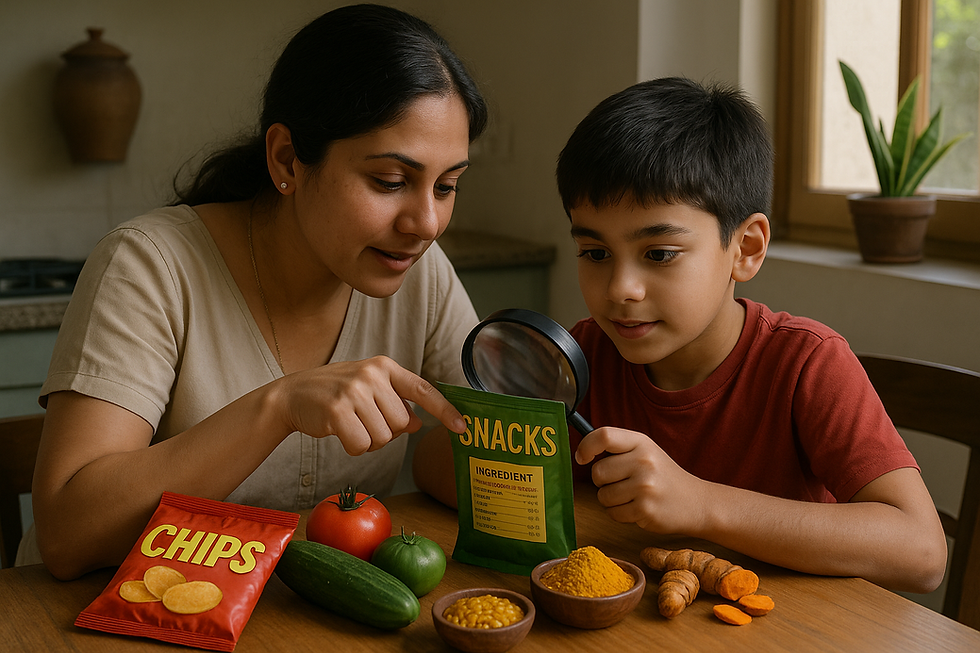DHA for Kids: A Parent's Complete Guide to Brain Health
- Dr Tejal Risbud Rao

- Jul 22
- 4 min read

What Is DHA? The Brain Food Your Child Needs
DHA (docosahexaenoic acid) is an omega-3 fatty acid that acts like superfood for your child's brain and eyes. It's one of the most important nutrients for healthy development.
The Science: DHA is synthesized from alpha-linolenic acid (ALA) in the body, though this conversion is limited (less than 10%), making dietary sources crucial. DHA plays a vital role in myelination, the process of forming protective sheaths around nerve fibers that speeds up brain signal transmission and is essential for cognitive development.
Think of DHA as premium fuel for your child's growing brain. During the first few years of life, your child's brain grows incredibly fast - and DHA helps make sure this happens properly.
Why Your Child's Brain Needs DHA
Key benefits include:

Faster brain development - Critical during the first 2 years
Better learning ability - May improve reading and math skills
Sharper memory and focus - Helps with school performance
Healthier eyes - Essential for good vision development
Better sleep patterns - Some studies show improved rest
Top DHA Food Sources for Families
Fish: Best Choices Locally Available
Fish Type | DHA per 100g | Local Name | Kid-Friendly Preparation |
Hilsa | 1,200-2,000 mg | Ilish | Fish curry with rice, steamed with mustard |
Pomfret | 800-1,200 mg | Paplet | Fish fry, curry, or steamed with ginger |
Mackerel | 1,000-1,500 mg | Bangda | Curry with coconut, fried with turmeric |
Sardines | 800-1,200 mg | Pedvey/Mathi | Curry with coconut milk, fried with spices |
Rohu | 200-400 mg | Rohu | Fish curry, fried, or in regional preparations |
Tuna | 200-300 mg | Tuna | Sandwiches, curry, or grilled |
Other Excellent DHA Sources
Eggs & Dairy:
Free-range eggs - 80-120 mg per egg (vs 20-30 mg in regular eggs)
DHA-fortified milk - 25-50 mg per cup
Omega-3 enriched dairy products - Available at most supermarkets
Traditional Plant Sources (contain ALA that converts to DHA):
Akhrot (Walnuts) - Add to halwa, kheer, or eat as snacks
Alsi seeds (Flaxseeds) - Mix in rotis, paranthas, or sweets
Chia seeds - Add to lassi, smoothies, or puddings
Til (Sesame seeds) - Use in ladoos, chutneys
For Vegetarian Families:
Algae oil supplements - Direct DHA source, same as fish get from algae
Seaweed/Nori sheets - Natural marine plant source
Fortified plant-based foods - Cereals, plant milks with added DHA
Does Your Child Need DHA Supplements?
Most kids DON'T need supplements if they:
✓ Eat fish twice per week
✓ Have a varied, balanced diet
✓ Drink fortified milk or eat omega-3 enriched foods
When DHA Supplements May Help
Consider supplements if your child:
1. Refuses Fish Completely
Won't try any fish despite different preparations
Has strong aversion to seafood
Only eats very limited foods
2. Follows Plant-Based Diet
Vegetarian or vegan family
Plant foods contain minimal direct DHA
Body converts only 1-10% of plant omega-3s to DHA
3. Has Special Dietary Needs
Autism spectrum with extremely limited diet
Sensory processing issues with food textures
Medical conditions affecting nutrient absorption
4. Was Born Premature
Missed crucial third trimester DHA accumulation
Often have higher DHA requirements
For Nursing Moms: If you don't eat fish, taking supplements yourself can boost your breast milk's DHA content.
How Much DHA Do Kids Need?
Age-Based Recommendations
Age Group | Daily DHA Target | Total Omega-3s |
2-3 years | 145 mg DHA minimum | 433 mg total |
4-6 years | 200 mg DHA minimum | 600 mg total |
7+ years | 200-300 mg DHA | 700-1000 mg total |
Research shows benefits with 120-1,300 mg combined DHA + EPA daily
Real-World Examples
1 serving hilsa = meets daily needs for several days
2 free-range eggs = about 160-240 mg DHA
100g pomfret = 800-1,200 mg DHA
Most kids supplements = 100-200 mg DHA per dose
Smart Ways to Boost DHA Naturally
Traditional omega-3 rich foods:

Practical Daily Meal Ideas
Meal Time | Best DHA Options | Omega-3 Content | Why Kids Love It |
Breakfast | Free-range egg bhurji | 80-120 mg | Familiar taste, goes with roti |
Alsi parantha | 50-80 mg | Sweet and filling | |
Lunch | Fish curry with rice | 200-800 mg | Comfort food with mild spices |
Akhrot pulao | 100-150 mg | Sweet rice with nuts | |
Dinner | Steamed pomfret | 300-500 mg | Light, flaky texture |
Snacks | Til ladoo | 60-80 mg | Traditional sweet treat |
Walnut halwa | 100-120 mg | Rich, satisfying dessert |
Adapting These Meals for Your Family
Vegetarian & Jain Families: Focus on akhrot pulao, alsi parantha, and traditional sweets. Add daily akhrot (2-3 walnuts) to any meal and use mustard oil for cooking.
Picky Eaters: Try hiding ground walnuts in halwa, flaxseed powder in parantha dough, or start with mild pomfret curry. Don't stress - supplements can bridge gaps while you keep trying.
Best Timing: Give DHA foods with main meals (morning eggs, lunch fish curry, evening walnut sweets) for better absorption and routine.
Choosing DHA Supplements When Needed
Quality Markers to Look For
✓ Government approved for safety and quality
✓ Clear DHA amount listed on label (not just total omega-3s)
✓ Age-appropriate form - syrups for toddlers, chewables for older kids
✓ Pleasant taste your child will actually take
For Vegetarian Families
Choose algae-based supplements:
Made from the same source that fish get their DHA from
Just as effective as fish oil
Completely vegetarian and vegan-friendly
Free from ocean pollutants
Fish oil supplements (for non-vegetarian families) are derived from fatty fish like anchovies, sardines, and mackerel, providing concentrated DHA and EPA in easy-to-take forms.
Dosage Guidelines
Ages 2-6: 100-200 mg DHA daily
Ages 7+: 200-300 mg DHA daily
Start with half dose to check tolerance
Safety & What Parents Should Know
DHA supplements are generally very safe for kids.
Most side effects are mild:
Common Side Effects
Fishy taste or burps - Try refrigerated supplements
Mild stomach upset - Take with food
Loose stools - Usually means dose is too high
Important Safety Notes
⚠️ Always consult your pediatrician before starting supplements
⚠️ Check for fish allergies before using fish oil
⚠️ Start with lower doses to test tolerance
⚠️ Store safely away from children
The Bottom Line for Parents

Most children eating a varied diet get adequate DHA without supplements. Focus on offering nutritious foods consistently rather than stressing about perfect nutrition.
Key Takeaway
Every child is different. Work with your pediatrician to determine the best approach for your family's unique situation. No supplement replaces a balanced, varied diet - the goal is supporting optimal development through good nutrition.





Comments